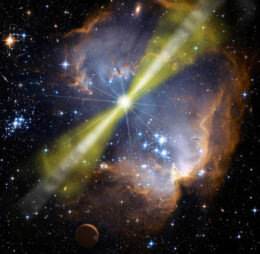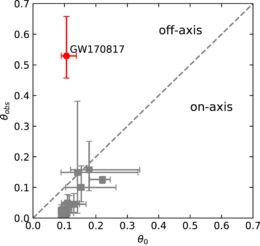Short-duration gamma-ray bursts (GRBs) are brief flashes of high-energy emission lasting less than two seconds. These events have long been hypothesized to occur when two neutron stars spiral in and collide, launching enormously powerful jets of light and matter. Can we now definitively make this connection?
A Singular Event?

Artist’s illustration of a gamma-ray burst. Could short gamma-ray bursts all be the product of neutron-star mergers? [NASA/Swift/Mary Pat Hrybyk-Keith/John Jones]
In the ensuing months and years, we’ve carefully analyzed the data supplied by this event, attempting to understand what makes this GRB light curve look the way it does. While GW170817’s gamma-ray emission shares some traits with the known population of observed short GRBs, it has a number of weird quirks.
GW170817’s host galaxy lies much closer than that of any other short GRB known, and its gamma-ray energies were perhaps 10,000 times lower than is typical among the short GRB population. GRB170817A’s afterglow — a long-lived glow that normally follows right after the initial gamma-ray flash of a GRB — only showed up 9 days after the flash.
So is the outflow from GW170817 actually the same as that in other short GRBs? And if so, does this mean that all short GRBs arise from neutron-star mergers?
Angles Matter
To address these questions, New York University scientists Yiyang Wu and Andrew MacFadyan explored the structure of GW170817’s outflow in comparison with a sample of 27 observed short GRBs. The authors modeled the GRB light curves allowing for a range of outflow structures — from spherical flows that splay out in all directions, to jetted structures that are tightly beamed in a specific direction.
From their fits, Wu and MacFadyan showed that the differences between GRB170817A’s light curve and those of the other GRBs can all be explained by one thing: viewing angle.

Plot of the viewing angle vs. opening angle for the jets of 17 known short GRBs and GW170817. While all have similar opening angles, GW170817 is the only one viewed significantly off-axis. [Wu & MacFadyan 2019]
Complications from Relativity
Why does viewing angle matter? Since these outflows are moving at nearly the speed of light, relativistic effects come into play. This means that energies and timescales can all look different depending on whether we’re viewing the jet on-axis or off-axis.
If GW170817 and the other GRBs can indeed all be explained by the exact same jet model, this is a powerful indicator that they all represent the same event. If true, that means that all short GRBs we’ve observed were also caused by the violent collision of two neutron stars somewhere in the distant universe.
Citation
“GW170817 Afterglow Reveals that Short Gamma-Ray Bursts are Neutron Star Mergers,” Yiyang Wu and Andrew MacFadyen 2019 ApJL 880 L23. doi:10.3847/2041-8213/ab2fd4

1 Comment
Pingback: Daily Log (2019-09-26) - Study Astrophysics